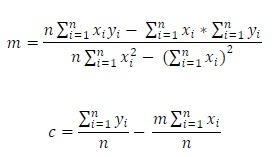
 Data Structure
Data Structure Networking
Networking RDBMS
RDBMS Operating System
Operating System Java
Java MS Excel
MS Excel iOS
iOS HTML
HTML CSS
CSS Android
Android Python
Python C Programming
C Programming C++
C++ C#
C# MongoDB
MongoDB MySQL
MySQL Javascript
Javascript PHP
PHP
- Selected Reading
- UPSC IAS Exams Notes
- Developer's Best Practices
- Questions and Answers
- Effective Resume Writing
- HR Interview Questions
- Computer Glossary
- Who is Who
Linear Regression
From a given set of data points, the linear regression finds an equation of straight line. The given points will follow the straight line. Using this formula, we can predict what will be the value for some other specific point, which is not present in the set currently.
For solving linear regression problems using some data points, we have to follow these formulae:

Here the m and c are the slope and the y-intercept respectively. Using these expressions, we can get the equation of straight line in this form: ? = ?? + ?.
Input and Output
Input:
The (x, y) coordinates of some points. {(1,3), (2,4), (3,5), (4,6), (5,8)}
Output:
The slope: 1.2 The Intercept: 1.6
The equation: y = 1.2x + 1.6
Algorithm
linReg(coord)
Input: The given set of coordinate points.
Output: The slope m and y-intercept c.
Begin for i := 1 to n, do sumX := sumX + coord[i,0] sumY := sumY + coord[i,1] sumXsq := sumXsq + (coord[i,0]*coord[i,0]) sumXY := sumXY + (coord[i,0] * coord[i,1]) done m := (n * sumXY – (sumX*sumY)) / (n * sumXsq – (sumX * sumX)) c := (sumY / n) – (m * sumX)/n End
Example
#include<iostream>
#include<cmath>
#define N 5
using namespace std;
void linReg(int coord[N][2], float &m, float &c) {
float sx2 = 0, sx = 0, sxy = 0, sy = 0;
for(int i = 0; i<N; i++) {
sx += coord[i][0]; //sum of x
sy += coord[i][1]; //sum of y
sx2 += coord[i][0]*coord[i][0]; //sum of x^2
sxy += coord[i][0]*coord[i][1]; //sum of x*y
}
// finding slope and intercept
m = (N*sxy-(sx*sy))/(N*sx2-(sx*sx));
c = (sy/N)-(m*sx)/N;
}
main() {
// this 2d array holds coordinate points
int point[N][2] = {{1,3},{2,4},{3,5},{4,6},{5,8}};
float m, c;
linReg(point, m, c);
cout << "The slope: " << m << " The Intercept: " << c << endl;
cout << "The equation: " << "y = "<< m <<"x + "<< c;
}
Output
The slope: 1.2 The Intercept: 1.6 The equation: y = 1.2x + 1.6

Advertisements
